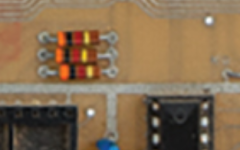Eudimorphodon
Veteran Member
Sold for $677K. So much for the theory that either condition or actual provenance matters for these things. It’s a token with a story, so it’s part of the club.
except for those darned resistor bands being aligned similarly
You might even do it intentionally because it makes it easier to visually compare and make sure you stuffed the sockets correctly if every board has the colours in the same order.Ever bought a bunch of resistors in those rolls where the leads are held together by paper tape? All the resistors in the roll tend to have the same alignment. If you’re the schmo sitting there snatching and stuffing parts on a batch of boards with max efficiency I would wager there’s a decent chance multiple units will end up with them in the same orientation. (And you, the schmo, will go home and complain about how much your wrists hurt from the repetitive motion at the end of the day.) Personally I don’t think it’s as compelling a piece of evidence as advertised.

The thing with the resistors is not about simple orientation.
Photo showing the alignment of some resistors on the Apple-1 PCB in question. You can clearly see the alignment/offset, resulting from the manually bent leads:
I agree, its either the same board or someone has 'tweaked' it to look the same, and maybe I like to think the best of people but I doubt its been tweaked.
The lack of 6502 capability means it must have been one of the very first whatever the argument about 'prototype'
Its all interesting, and thats what this hobby is about
but almost 700k !!!!!
Utterly daft, but hey. Somewhere someone has a grin from ear to ear.
Your talking usefulness of course.. But Im pretty sure ANY of us would gladly take an Apple-1 into our collection. ITs THE MOST OVERATED vintage computer out there, but it still has a place in collecting. The Apple-1 didnt make Apple the company it is. The Apple II Made Apple famous and wealthy.. It seems these fanboys and Jobs cultists keep trying to re-write history.Until they get it home. It’s junk.
I’ll take a apple IIgs over a apple 1 every single day.
The thing with the resistors is not about simple orientation. Of course the resistors are all oriented consistently. Even a beginner hobbyist with a bit of pride in his build takes care of consistently orienting resistors, so the board looks neat.
As I understood it, the question of alignment refers to the slight offset of the resistors. This happens when you manually bend the leads, without the help of a bending tool. As a result, the resistor body is not exactly centered - and the offset will vary for each resistor. The combination of these offsets makes each manually soldered board unique.
If the resistor alignment exactly matches old photos, then this cannot be a coincidence. But of course it does not exclude a carefully made fake...
Photo showing the alignment of some resistors on the Apple-1 PCB in question. You can clearly see the alignment/offset, resulting from the manually bent leads:
View attachment 1245084

I meant the seller was the one smiling from ear to earUntil they get it home. It’s junk.
I’ll take a apple IIgs over a apple 1 every single day.
Yes, it does have its place.Your talking usefulness of course.. But Im pretty sure ANY of us would gladly take an Apple-1 into our collection. ITs THE MOST OVERATED vintage computer out there, but it still has a place in collecting. The Apple-1 didnt make Apple the company it is. The Apple II Made Apple famous and wealthy.. It seems these fanboys and Jobs cultists keep trying to re-write history.
The lack of 6502 capability means it must have been one of the very first whatever the argument about 'prototype'
Possible point of order here: according to the notes in the Apple 1 user manual those two points labeled “6502” are specifically supposed to be opened *only* if a 6800 CPU is installed. The manual doesn’t mention the 6501, probably because it was already basically discontinued by mid-1976 and any price difference between it and the 6502 had disappeared, but if you look at the schematics with regard to what changes on the motherboard when you open those jumpers it appears they concern tri-state address bus control and an “address valid” output... and despite being “pin-compatible” with the 6800 the 6501 critically lacks the tri-state control and just outputs a dummy VBE signal. Both pins are NC on a 6502 and a 6501 wouldn’t care either if they were disconnected. So… there’s actually a really good chance this version of the board supports a 6502, just omit the clock driver. What it *doesn’t* support… apparently, maybe there’s a trace cut alternative, is a 6800.
